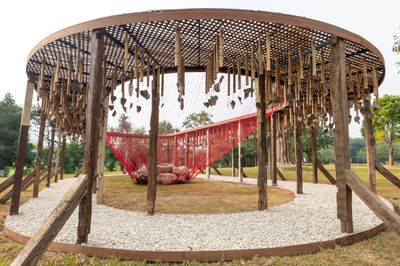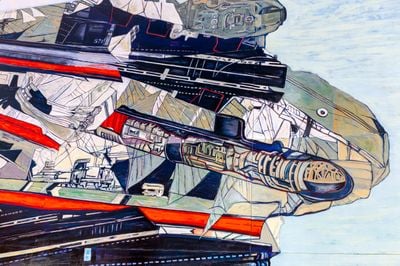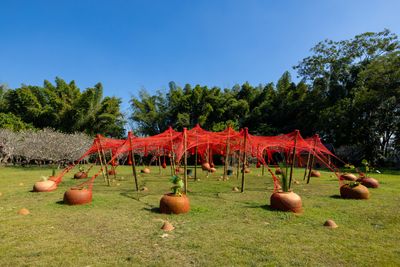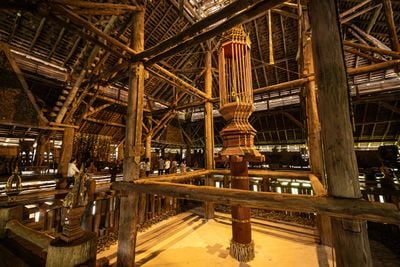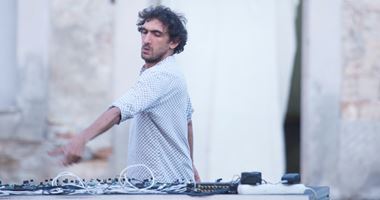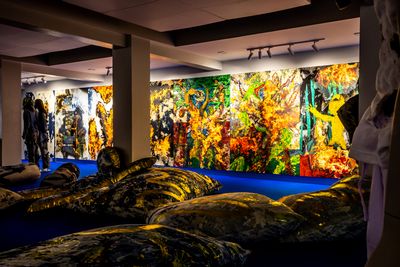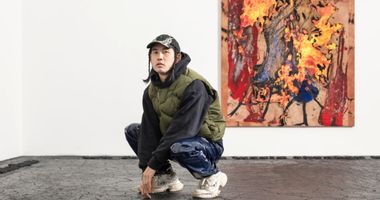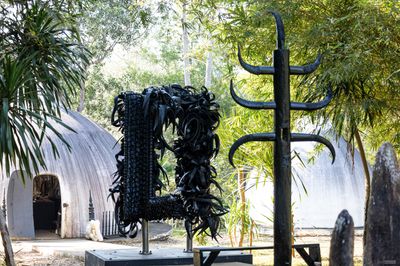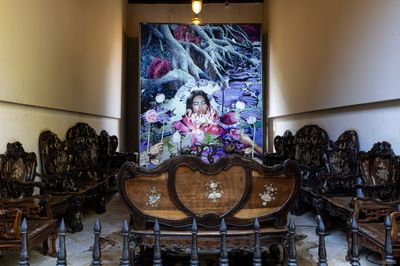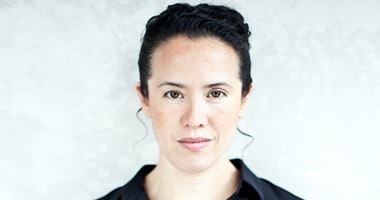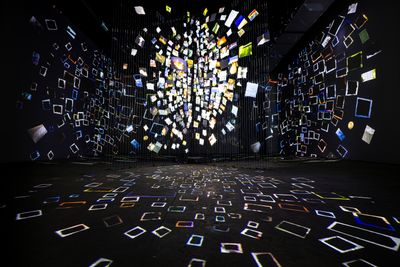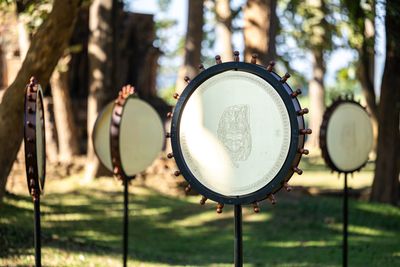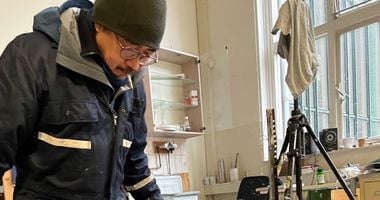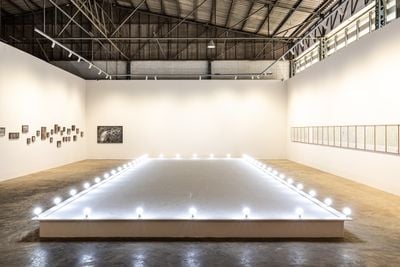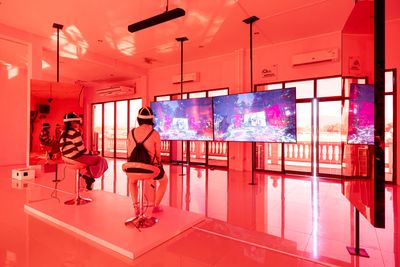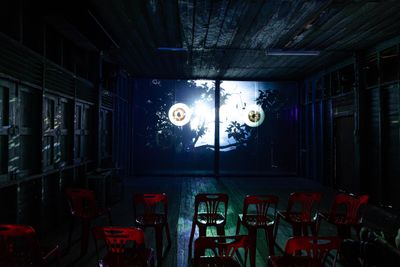Thailand Biennale Experiments with the Golden Triangle

Navin Rawanchaikul and studiOK, Displaced, Whose Land? (2023). Exhibition view: Thailand Biennale, Chiang Rai 2023: The Open World (9 December 2023–30 April 2024). Courtesy Thailand Biennale. Photo: Wanchai Phutthawarin.
Zian Chen walks us through The Open World as it unfolds across Thailand's northernmost cities, at sites as divergent as Wat Rong Khun (White Temple) and the Chiang Saen community centre.
The nomadic Thailand Biennale this year occupies space in Chiang Saen and Chiang Rai, within a region known as the Golden Triangle, a border zone connecting Myanmar, Thailand, and Laos.
The Open World (9 December 2023–30 April 2024) encompasses 17 locations from vernacular temples to more modest public facilities such as a community centre facing the casino high-rises in Laos across the bordering river.
At the Mekong Basin Civilization Museum in Chiang Rai, works are shown in juxtaposition with the museum's collection of antiquities from the ancient Lanna Kingdom, which once thrived in the basin.
Singha Nava Kumara Airship (2023), a monumental mural of an airship in water by Chiang Mai-based artist-activist known as Ubatsat, is viewed when passing a Buddhist pulpit adorned with colourful aluminium foils. Suspended against cabinets displaying ethnographic artefacts, the mural appears to integrate the vessel into the gallery's altar.
In contrast to the museum's compact display, the exhibition takes on a different rhythm within the expansive Mae Fah Luang Art and Cultural Park—an erstwhile arsenal site linked to the opium trade, later transformed into a royal institution providing education for the hill-tribe population.
The park hosts artworks using organic materials, creating rich outdoor experiences. Ernesto Neto's subtle land artwork, Chantdance (2023), resembles a vast web crocheted from recycled fibres, adorned with gravity drops, each filled with spices that accentuate tactile and olfactory senses.
Installed at a Lanna-style stilt pavilion on the site, Nguyen Trinh Thi's commission Sound-Less (2023) comprises a series of sound sets, each crafted to replicate one of the 20-some tones of a Thai xylophone, placed throughout the entire unlit royal pavilion.
The space, adorned with manuscript cabinets and Buddha sculptures collected from the northern provinces, is punctuated by the luminous glow of LED lights emanating from Nguyen's electronic components, indicating that this monotonous percussion is linked to the data collection of the Mekong River's waterflow elsewhere.
Just a few steps away from Sound-Less, through a verdant outdoor garden, is Tarek Atoui's woodwind orchestra, The Wind Harvesters (2023). In an open-air pavilion, Atoui has meticulously tuned and automatised bamboo-based flutes and reed pipes into a sound installation operated by hydro and wind power.
Commonly used by the Akha and Lisu tribes, the instruments are arrayed in the pavilion's central court, creating the sensation of standing in a rice field surrounded by bamboo pipes, which simultaneously serve as both musical and irrigation tools.
Within this biennial's grounded focus, New York-based Korakrit Arunanondchai's participation at Wat Rong Khun (White Temple) reflects a return to source. One of Chiang Rai's most visited tourist attractions, the modern temple features kitsch décor carved out of white plaster and mirror fragments, conceived by local art maestro Chalermchai Kositpipat.
Here, Arunanondchai presents his career-defining video and painting series, 2557 (Painting with history in a room filled with men with funny names 2) (2014). The work depicts the temple as both a road trip destination and a source of inspiration for Arunanondchai's series of denim-based abstract expressionist action paintings presented in the space.
In one pivotal scene, Arunanondchai channels Kositpipat's TV interview where he performs exaggerated kung fu motions, to create these action paintings, using bodily kung fu strokes to apply paint to the canvas. This revisit highlights Kositpipat's influence on themes of Asian brotherhood chic in Arunanondchai's work, which is often seen as mirroring 'American masculinity.'
Beyond Arunanondchai's half-hearted critique, the unexplored aspects of masculinity find scrutiny within the Black House, where the late artist Thawan Duchanee designed over 40 temple structures made of black teak wood since the 1970s, to house hundreds of his vulgar sculptures.
The biennial decisively introduces feminist critiques in this space, with Black American artist Chakaia Booker's What's Not (2009). A monumental, hollowed frame enveloped by decomposed rubber tires like vibrant wild grass, creates a view of the Black Houses in the distance, reinterpreting monumentality and heroism in sculpture.
Nearby, Busui Ajaw from Myanmar's Akha region presents eight buffalo hide paintings that celebrate the Akha mother spirit, Amamata, while Kamonlak Sukchai's Red Lotus (2019), a photo-collage series displayed within the exaggeratedly ornate living room of a teak wood house, depicts deities and a young female protagonist adorned in traditional Thai attire with subversive command.
Throughout the biennale, a diverse array of regional dialogues with artists from across Asia results in an exhibition composed of a series of contemporary folklores, that seem to transcend the political borderlines that define the Golden Triangle as the meeting point between three nation states.
Yet, despite a curatorial emphasis on translocalism, the active involvement of local artists remains uneven. Notably, Chiang Rai-based artist Sompong Sarasap presents a series of large-scale murals on canvas portraying surreal landscapes featuring an oversized human skeleton. These works are showcased in the artist's own studio, devoid of any curatorial framing—creating a contrast between how local Chiang Rai artists have been included in the show, and their international counterparts presented in the sole white cube venue, the Chiang Rai International Art Museum. Here, Pierre Huyghe's classic posthuman 2014 film, Untitled (Human Mask) (2014), featuring a Noh theatre-masked monkey in an post-apocalyptic world, shares space with installations by Haegue Yang and Sara Sze, among others.
Nevertheless, this chapter of the biennale in Chiang Rai seems to prime visitors for the continuation of the show in Chiang Saen, the heart of the Golden Triangle and an ancient capital rich in complex historical layers. Designed for a day trip, seven scattered venues, connected by official shuttle, include the historic Wat Pa Sak Temple, where base-relief Buddha portraits feature the subtle hand gesture for Open World, which inspired the biennale's title.
Housed within this ancient setting is Chitti Kasemkitvatana's Kala Ensemble (2023): 12 victory drums traditionally used in Lanna rituals. They bear inscriptions that showcase an excerpt of Buddhist cosmology translated into 12 languages including Tham Lanna, Shan, Burmese, and Laotian scripts, which have significantly influenced the diverse historical trajectories of Buddhism.
The venues in Chiang Saen generally feature only a few works at each location. An exception to this approach is the Chang Warehouse, located on the outskirts of Chiang Saen, bordering Bokeo province in Laos. Perhaps the most meticulously curated space in the entire biennial, this border warehouse offers a unique backdrop for contemplating the political economy of the Golden Triangle.
Titled 'The Opium Parallax' (2019–), a series of widely exhibited black-and-white diagram paintings by Sawangwongse Yawnghwe, resembles blackboards found in a CIA station, with keywords and lines mapping out the otherwise opaque network of the opium trade. In the adjoining video room, Ho Tzu Nyen's The Critical Dictionary of Southeast Asia: O for Opium (2022) epitomises object-based cinema using idiosyncratic double exposure, condensing an array of film excerpts to weave a macro-narrative about the substance.
Moving beyond opium as the medium for illustrating geopolitical complexity, Nipan Oranniwesna's Silence Traces (2023) centres on the performative dimensions of border-making through cartography. The piece contrasts Oranniwesna's renowned cityscape installation, where mixed city maps dusted with powder form an imaginary city. A series of connected maps of Chiang Rai on the wall outline neighbouring territories, reflecting how maps are utilised by administrative bodies.
Meanwhile, Yunan-based artist Cheng Xinhao's compelling 40-minute video essay, March of Elephant (2022), employs a mix of archival sources, including religious murals and official records, to explore the elephant as a sacred regional symbol. It probes the history of human and animal interactions, focusing on how Chinese communism's elephant taming projects—viewed by the artist as the ultimate metaphor for controlling border-crossing activities—have contributed to nation-building efforts.
Possibly prompted by prior works about the descendants of a Chinese Kuomintang guerrilla team in the area, Hsu Chia-Wei's commissioned VR film The Actor from Golden Triangle (2023), is presented in a control-room-like community centre in Chiang Saen.
The film features Oak Keerati, a professional actor known for his roles in films set in the Northern Thailand region, such as Operation Mekong (2016) and Thai Cave Rescue (2022), who also runs a family-owned opium history museum nearby. Keerati plays a shape-shifting character, performing rap lyrics drawn from local poppy flower folklore.
Traversing a mountainous road, my road trip around The Open World ended on a high note when reaching Apichatpong Weerasethakul's film installation Motion Pictures (2023) at dusk. Weerasethakul ingeniously transformed a rural classroom into an experimental cinematic device to present Solarium (2023), a double-projection setup bisected by a translucent screen to capture images from both sides.
Solarium depicts a man in a white shirt, mostly viewed from behind, wandering slowly in a dimly lit room filled with suspended objects resembling glowing eyeballs. As the lighting shifts, these objects gently sway, casting an otherworldly glow that creates a haunting, holographic illusion, enveloping the viewer in a nearly abstract, non-diegetic narrative.
These visuals, accompanied by cinematic glitch effects, are further heightened by a subwoofer rocking the entire space, adding a dynamic auditory dimension to this visually rich spectacle, which is one way of describing The Open World as a whole. —[O]

